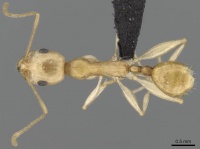Royidris etiolata
| Royidris etiolata | |
|---|---|

| |
| Scientific classification | |
| Kingdom: | Animalia |
| Phylum: | Arthropoda |
| Class: | Insecta |
| Order: | Hymenoptera |
| Family: | Formicidae |
| Subfamily: | Myrmicinae |
| Tribe: | Crematogastrini |
| Genus: | Royidris |
| Species group: | notorthotenes |
| Species: | R. etiolata |
| Binomial name | |
| Royidris etiolata Bolton & Fisher, 2014 | |
R. etiolata nests under stones in spiny forest.
Identification
A member of the notorthotenes species group. Bolton and Fisher (2014) - Workers of etiolata mostly conform to the description of Royidris notorthotenes. The two are closely related but separated by the comparative dimensions noted below, most striking of which is the extremely elongate scape. In addition, etiolata is a more gracile species. Its head in full-face view has the sides behind the eyes strongly convergent posteriorly, so that the transverse portion of the posterior margin always appears shorter and narrower than in notorthotenes. For comparison of measurements see Table 3, Bolton and Fisher 2014.
Keys including this Species
Distribution
Endemic to Madagascar.
Latitudinal Distribution Pattern
Latitudinal Range: -24.650556° to -24.650556°.
| North Temperate |
North Subtropical |
Tropical | South Subtropical |
South Temperate |
- Source: AntMaps
Distribution based on Regional Taxon Lists
Malagasy Region: Madagascar (type locality).
Distribution based on AntMaps
Distribution based on AntWeb specimens
Check data from AntWeb
Countries Occupied
| Number of countries occupied by this species based on AntWiki Regional Taxon Lists. In general, fewer countries occupied indicates a narrower range, while more countries indicates a more widespread species. |

|
Estimated Abundance
| Relative abundance based on number of AntMaps records per species (this species within the purple bar). Fewer records (to the left) indicates a less abundant/encountered species while more records (to the right) indicates more abundant/encountered species. |

|
Biology
Castes
Known only from the worker caste.
Nomenclature
The following information is derived from Barry Bolton's Online Catalogue of the Ants of the World.
- etiolata. Royidris etiolata Bolton & Fisher, 2014: 52, figs. 51-53 (w.) MADAGASCAR.
- Type-material: holotype worker, 9 paratype workers.
- Type-locality: Madagascar: Prov. Toliara, Mahafaly Plateau, 6.2 km. 74° ENE Itampolo, 80 m., 24°39.2’S, 43°59.8’E, 21-25.ii.2002, BLF 5796, CASENT0002370 (holotype), under stone, spiny forest thicket (B.L. Fisher et al); paratypes with same data (all BLF 5796).
- Type-depositories: CASC (holotype); BMNH, CASC (paratypes).
- Distribution: Madagascar.
Unless otherwise noted the text for the remainder of this section is reported from the publication that includes the original description.
Description
Worker
(holotype in parentheses). TL 3.5–4.2 (3.9), HL 0.88–1.00 (0.98), HW 0.66–0.77 (0.75), CI 75–78 (77), SL 1.04–1.20 (1.14), SI 148–158 (152), PW 0.42–0.50 (0.48), WL 1.14–1.36 (1.30) (11 measured). EL 0.21–0.24 (EL/HW 0.31–0.32). MfL 0.98–1.14 (MfL/HW 1.46–1.50, MfL/MfH 4.00–4.38).
Workers of etiolata mostly conform to the description of Royidris notorthotenes. The two are closely related but separated by the comparative dimensions noted below, most striking of which is the extremely elongate scape. In addition, etiolata is a more gracile species. Its head in full-face view has the sides behind the eyes strongly convergent posteriorly, so that the transverse portion of the posterior margin always appears shorter and narrower than in notorthotenes. For comparison of measurements see Table 3, Bolton and Fisher 2014.
Type Material
Holotype worker, Madagascar: Prov. Toliara, Mahafaly Plateau, 6.2 km. 74° ENE Itampolo, 24°39.2’S, 43°59.8’E, 80 m., 21–25.ii.2002, BLF 5796, CASENT0002370, under stone, spiny forest/thicket (Fisher et al.) (California Academy of Sciences). Paratypes. 9 workers with same data as holotype but 3 workers CASENT0002371, 1 worker CASENT0002372, 1 worker CASENT0002437, 3 workers CASENT0002438, 1 worker CASENT0009799 (CASC, The Natural History Museum).
References
- Bolton, B. & Fisher, B.L. 2014. The Madagascan endemic myrmicine ants related to Eutetramorium (Hymenoptera: Formicidae): taxonomy of the genera Eutetramorium Emery, Malagidris nom. n., Myrmisaraka gen. n., Royidris gen. n., and Vitsika gen. n. Zootaxa 3791:1–99. doi:10.11646/zootaxa.3791.1.1
References based on Global Ant Biodiversity Informatics
- Bolton B., and B. L. Fisher. 2014. The Madagascan endemic myrmicine ants related to Eutetramorium (Hymenoptera: Formicidae): taxonomy of the genera Eutetramorium Emery, Malagidris nom. n., Myrmisaraka gen. n., Royidris gen. n., and Vitsika gen. n. Zootaxa 3791(1): 1-99.

